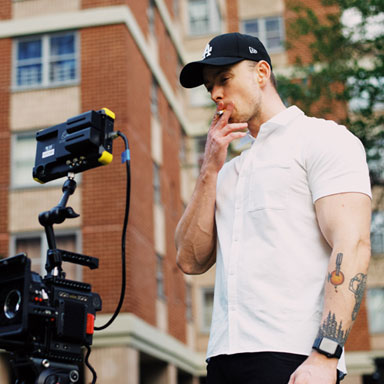Report: Indie Film Production
Our “Indie Film Production” Report is our opinions of the state-of-affairs for the Hollywood business of Independent Film Production. This is a huge topic with plenty to write about and we will expose our opinions on everything from the number of films being produced to who is producing them to the technical aspects employed. If you have experiences you would like to share, please send us your comments.

© moviesbyespresso
“A Studio Film is produced and created by a large Film making company and always invests higher amounts into production than the normal Indie.”

Billy LAx – Chief Editor
Within the Hollywood film production business, there are two categories of Film production: A Studio film; and an Independent Film (commonly called an Indie by Hollywood insiders) Ten major studios produce studio films as compared to hundreds of Independent Film Companies. A studio film has a facility and normally multiple facilities to build production sets within and lots of funding to build expensive sets outside of the studio. A Studio film normally uses ‘A’ list actors and the cost for those actors is usually way more than the Indies. A studio film normally stays with the conventional movie plots and stories that appeal to the general public audiences taking a little risk of failure.
Independents are much more apt to use plots and storylines that the Filmmakers elect to manifest their artistic natures. However, Independents also create low budget normal films on low-cost sets, commonly called ‘B’ films. These ‘B’ films are often targeted to foreign markets as well as marketing them to television networks. An Independent film is building your own company every time you want to make a movie. Commonly they are funded by a combination of foreign pre-sales and an equity investor. These films are generally bonded with completion bonds, but not necessarily. Without completion bonds, no institutional investor is used, going with a plain equity funder from beginning to end. Requiring a completion bond also puts constraints on the film such as who the cast is, who is directing it, the timeline of the shoot, the distribution companies, and their presales contracts, amongst other more minor requirements. Commonly, an Independent Film can range from $12000 to $70 Million. A Studio film will start at $30 Million and range to $250 Million.
Studio Financing is a templated-out system done the same way each year multiple times. It is mainly within the same set of companies and the studios can own the domestic theater release which guarantees the all-important promotion with Box Office receipts. A studio film’s ‘A’ list cast and directors as well as the studio’s brand name also guarantees a return to the studio and/or institutional investor of the principle used to create the movie. Financing an Independent film imposes more risk than a studio film and more complicated risk than a studio film but far more upside potential for a successful film. If the budget to finance an Indie is to low to hire marquee talent, then there are no presales or guaranteed revenue from any venue and the filmmaker must sell the film based on the finished product.
Most of these films do not find distribution and will loose for the investor, the entire production cost. If the Independent producer does find an equity partner with a $1 Million plus investment, he can sign a cast to guarantee a production budget return by presales, however, the production budget has to match the marquee talent return or part of it will be lost if the movie does not do well. To get an Independent Financier to forgo the risk of moving production funding to an account for the production of a movie and having the movie not be made is that the financier often requires that the marquee talent sign Letters of Intent (LOI) make the movie.
Usually, these LOI’s are based on a script and a director being attached.
To get the talent attached, it normally requires a producer to put up 10% of the talent fee. This puts the producer at high risk because he then has to get the equity player to invest in the film package or has to get the filmmakers to make the movie on a low presales budget. A screenplay with the attached cast and director is often called a film package and many times Agencies that represent marquee talent will put together the package attaching the talent.
CC Bell – Content Writer
When I was a kid, ten to fifteen years ago, I was all about Studio movies. Big-name stars are what I knew. Leo, Ben and Matt were the biggest. I could not get enough of the sound effects and animation visuals from movies like the Avatar. But then I started looking at the film in a more mature way. A sophisticated way. Paying more attention to actors and character chemistry. Into story’s, especially off-beat stories. I have very much surprised myself with the change in taste in a short period of time. Most of my friends are still into big-budget films, but not me. I find myself googling Cannes selected movies and watching which movies will get the coveted ‘buzz’ out of Sundance and Venice Film Festivals as well as The American Film Market. I know the Independent actors well now, as well as the A-list of course and I know the directors. I guess this makes me a true Indie follower and made for Espresso Films to write for billyLAx, our Chief Film editor.
Independent film making is so much more creative and exciting than the studio films. Of course, there is more recognition in the mega-budget films, but the Indies is where all the character and charm of making movies are. From first time filmmakers to filmmakers who are putting together their fiftieth movie, there is no place like the excitement of a film festival or film market. If you are on the production staff of a big-budget movie, in the end, you take your paycheck and go home. Not on an Indie, for the most part. You are encouraged to help market the film you have made. Actors who have starred on the Indies often play major roles in marketing the movie at showcasing, markets, and festivals. The whole production and distribution staff are often tight with the Indies. The stars often are part of this community and know each other well. Can you imagine an A-lister having a beer with the cameraman at the American Film Market?
Putting together an Indie requires a much different business process than putting together a Studio film. For an Indie, the producer and owner are required to put together each part of the film project, from concept to selling the “film in the can.” This can be exciting but frustrating at the same time, starting with the biggest catch 22 in the business; you cannot attach talent without money, and you cannot get money without talent. This is where packagers come in and they are often agents or studios or solidified production companies. Agents can sign the talent and get the money afterword; Studios or solidified production companies can put up the budget and make offers to talent. Since they have film competency, there is a low risk they cannot sign the talent. But there still is a reputational risk that if a production company puts up the money and can’t sign the talent, the egg is obviously on their face.
Investment in Indies is way more volatile than studio investment in the blockbusters. As an Indie investor, you can lose your shirt, to make hundreds of times the rate of return on your investment, depending on the quality of the film and the deal set up for your investment. Investing in and Indie uses to be ladened with shady deals, but in recent years, the SEC has set laws for investors protecting them from the old boiler rooms. Now, only sophisticated high dollar investors can be approached for investment in film packages. One problem with this is the small filmmaker has no way of getting low dollar investors. The lawmakers work-around this, gave rise to “Gofundme” networks. Now, if you have a film that fits the mould of a “Gofundme” project, which is usually something with a social agenda, then you may be successful with getting funded.

Changes in Hollywood latitudes: Virus
Espresso editors believe that the impact of COVID19 has produced such a huge effect on Hollywood that it warrants a dedicated page of opinions.

Entertainment
Editorials in our “Better Now than Ever” theme put a positive spin on our illustrious Film Industry as well as our Film careers.
Jared A. Wignall – A Leading man is ready to blast off

Ever since I was young, I wanted to be an actor. I don’t believe there was...
LeAnne Weber – Hey Indie world… Here’s your new star!

I remember the first time I saw a live production. I was around 4 years old,...
FOLLOW US ON INSTAGRAM @moviesbyespresso




